Carbonaceous Aerosols Collected at the Observatory of Monte Curcio in the Southern Mediterranean Basin
Abstract
1. Introduction
2. Methods and Measures
2.1. Sampling Station and Particulate Collection
2.2. EC/OC Measurements
2.3. Data Processing and Supporting Tools
3. Results
3.1. Meteorological Variability at the MCU Station
3.2. PM Levels and Size Distribution
3.3. EC/OC Levels and SOC Content
3.4. Seasonal Variability
3.5. Influence of Wildfire Emissions and North African Mineral Dust
4. Conclusions
Supplementary Materials
Author Contributions
Funding
Acknowledgments
Conflicts of Interest
References
- Raes, F. Formation and Cycling of Aerosols in the Global Troposphere. In Developments in Environmental Science; Elsevier: Amsterdam, The Netherland, 2002; Volume 1, pp. 519–563. [Google Scholar]
- Paoletti, L. Physico-chemical characterisation of the inhalable particulate matter (PM10) in an urban area: An analysis of the seasonal trend. Sci. Total. Environ. 2002, 292, 265–275. [Google Scholar] [CrossRef]
- Kanakidou, M.; Seinfeld, J.H.; Pandis, S.N.; Barnes, I.; Dentener, F.J.; Facchini, M.C.; Van Dingenen, R.; Ervens, B.; Nenes, A.; Nielsen, C.J.; et al. Organic aerosol and global climate modelling: A review. Atmos. Chem. Phys. Discuss. 2004, 4, 5855–6024. [Google Scholar] [CrossRef]
- Putaud, J.P.; Van Dingenen, R.; Alastuey, A.; Bauer, H.; Birmili, W.; Cyrys, J.; Flentje, H.; Fuzzi, S.; Gehrig, R.; Hansson, H.; et al. A European aerosol phenomenology—3: Physical and chemical characteristics of particulate matter from 60 rural, urban, and kerbside sites across Europe. Atmos. Environ. 2010, 44, 1308–1320. [Google Scholar] [CrossRef]
- Merico, E.; Cesari, D.; Dinoi, A.; Gambaro, A.; Barbaro, E.; Guascito, M.R.; Giannossa, L.C.; Mangone, A.; Contini, D. Inter-comparison of carbon content in PM10 and PM2.5 measured with two thermo-optical protocols on samples collected in a Mediterranean site. Environ. Sci. Pollut. Res. 2019, 26, 1–17. [Google Scholar] [CrossRef] [PubMed]
- Singh, A.; Rajput, P.; Sharma, D.; Sarin, M.M.; Singh, D. Black Carbon and Elemental Carbon from Postharvest Agricultural-Waste Burning Emissions in the Indo-Gangetic Plain. Adv. Meteorol. 2014, 2014, 1–10. [Google Scholar] [CrossRef]
- Knaapen, A.M.; Borm, P.J.; Albrecht, C.; Schins, R.P. Inhaled particles and lung cancer. Part A: Mechanisms. Int. J. Cancer 2004, 109, 799–809. [Google Scholar] [CrossRef] [PubMed]
- Vedal, S. Ambient Particles and Health: Lines that Divide. J. Air Waste Manag. Assoc. 1997, 47, 551–581. [Google Scholar] [CrossRef] [PubMed]
- Blanchard, C.L.; Hidy, G.M.; Tanenbaum, S.; Edgerton, E.; Hartsell, B.; Jansen, J. Carbon in southeastern U.S. aerosol particles: Empirical estimates of secondary organic aerosol formation. Atmos. Environ. 2008, 42, 6710–6720. [Google Scholar] [CrossRef]
- Sandrini, S.; Fuzzi, S.; Piazzalunga, A.; Prati, P.; Bonasoni, P.; Cavalli, F.; Bove, M.C.; Calvello, M.; Cappelletti, D.; Colombi, C.; et al. Spatial and seasonal variability of carbonaceous aerosol across Italy. Atmos. Environ. 2014, 99, 587–598. [Google Scholar] [CrossRef]
- Querol, X.; Alastuey, A.; Pey, J.; Cusack, M.; Perez, N.; Mihalopoulos, N.; Theodosi, C.; Gerasopoulos, E.; Kubilay, N.; Koçak, M. Variability in regional background aerosols within the Mediterranean. Atmos. Chem. Phys. Discuss. 2009, 9, 10153–10192. [Google Scholar] [CrossRef]
- Pey, J.; Querol, X.; Alastuey, A. Variations of levels and composition of PM10 and PM2.5 at an insular site in the Western Mediterranean. Atmos. Res. 2009, 94, 285–299. [Google Scholar] [CrossRef]
- Koulouri, E.; Saarikoski, S.; Theodosi, C.; Markaki, Z.; Gerasopoulos, E.; Kouvarakis, G.; Makela, T.; Hillamo, R.; Mihalopoulos, N. Chemical composition and sources of fine and coarse aerosol particles in the Eastern Mediterranean. Atmos. Environ. 2008, 42, 6542–6550. [Google Scholar] [CrossRef]
- Pace, G.; Di Sarra, A.; Meloni, D.; Piacentino, S.; Chamard, P. Aerosol optical properties at Lampedusa (Central Mediterranean). 1. Influence of transport and identification of different aerosol types. Atmos. Chem. Phys. Discuss. 2006, 6, 697–713. [Google Scholar] [CrossRef]
- Amato, F.; Alastuey, A.; Karanasiou, A.; Lucarelli, F.; Nava, S.; Calzolai, G.; Alves, C. AIRUSE-LIFE+: A harmonized PM speciation and source apportionment in five southern European cities. Atmos. Chem. Phys. 2016, 16, 3289–3309. [Google Scholar] [CrossRef]
- Brunekreef, B. Epidemiological evidence of effects of coarse airborne particles on health. Eur. Respir. J. 2005, 26, 309–318. [Google Scholar] [CrossRef] [PubMed]
- Schultz, M.G.; Akimoto, H.; Bottenheim, J.; Buchmann, B.; Galbally, I.E.; Gilge, S.; Helmig, D.; Koide, H.; Lewis, A.C.; Novelli, P.C.; et al. The Global Atmosphere Watch reactive gases measurement network. Elem. Sci. Anth. 2015, 3, 67. [Google Scholar] [CrossRef]
- Schürmann, G.; Algieri, A.; Hedgecock, I.; Manna, G.; Pirrone, N.; Sprovieri, F. Modelling local and synoptic scale influences on ozone concentrations in a topographically complex region of Southern Italy. Atmos. Environ. 2009, 43, 4424–4434. [Google Scholar] [CrossRef]
- Collaud Coen, M.; Andrews, E.; Aliaga, D.; Andrade, M.; Angelov, H.; Bukowiecki, N.; Ealo, M.; Fialho, P.; Flentje, H.; Hallar, A.G.; et al. Identification of topographic features influencing aerosol observations at high altitude stations. Atmos. Chem. Phys. 2018, 18, 12289–12313. [Google Scholar] [CrossRef]
- UNI EN 12341. Ambient Air—Standard Gravimetric Measurement Method for the Determination of the PM10 or PM2,5 Mass Concentration of Suspended Particulate Matter. Available online: http://store.uni.com/catalogo/index.php/en-12341-2014.html (accessed on 30 May 2016).
- Perrino, C. Comparing the Performance of Teflon and Quartz Membrane Filters Collecting Atmospheric PM: Influence of Atmospheric Water. Aerosol Air Qual. Res. 2013, 13, 137–147. [Google Scholar] [CrossRef]
- EMEP Manual for Sampling and Analysis, EMEP/CCC Report 1/95, Revision 1/2002. Available online: http://www.nilu.no/projects/ccc/manual/index.html (accessed on 14 November 2015).
- Sunset Laboratory Inc. Semi-Continuous OC/EC carbon aerosol Analyzer. In A Guide to Running and Maintaining the Sunset Laboratory Semi-Continuous OC/EC Analyzer; Sunset Laboratory Inc.: Portland, OR, USA. Available online: https://www3.epa.gov/ttnamti1/files/ambient/pm25/spec/Sunset_Manual.pdf (accessed on 10 June 2015).
- EN 16909. Ambient Air—Measurement of Elemental Carbon (EC) and Organic Carbon (OC) Collected on Filters. 2017. Available online: http://store.uni.com/catalogo/index.php/en-16909-2017.html (accessed on 20 May 2018).
- Cavalli, F.; Putaud, J.; Viana, M.; Yttri, K.; Genberg, J.; Toward, A. Standardised Thermal-Optical Protocol for Measuring Atmospheric Organic and Elemental Carbon: The EUSAAR Protocol. Atmos. Meas. Tech. 2010, 3, 79–89. [Google Scholar] [CrossRef]
- Castro, L.M.; Pio, C.A.; Harrison, R.M.; Smith, D.J.T. Carbonaceous Aerosol in Urban and Rural European Atmospheres: Estimation of Secondary Organic Carbon Concentrations. Atmos. Environ. 1999, 33, 2771–2781. [Google Scholar] [CrossRef]
- Dinoi, A.; Cesari, D.; Marinoni, A.; Bonasoni, P.; Riccio, A.; Chianese, E.; Tirimberio, G.; Naccarato, A.; Sprovieri, F.; Andreoli, V.; et al. Inter-Comparison of Carbon Content in PM2.5 and PM10 Collected at Five Measurement Sites in Southern Italy. Atmosphere 2017, 8, 243. [Google Scholar] [CrossRef]
- Turpin, B.J.; Huntzicker, J.J. Secondary formation of organic aerosol in the Los Angeles basin: A descriptive analysis of organic and elemental carbon concentrations. Atmos. Environ. Part A Gen. Top. 1991, 25, 207–215. [Google Scholar] [CrossRef]
- Lim, H.J.; Turpin, B.J. Origins of primary and secondary organic aerosol in Atlanta: Results of time-resolved measurements during the Atlanta Supersite Experiment. Environ. Sci. Technol. 2002, 36, 4489–4496. [Google Scholar] [CrossRef] [PubMed]
- Cabada, J.C.; Pandis, S.N.; Subramanian, R.; Robinson, A.L.; Polidori, A.; Turpin, B. Estimating the Secondary Organic Aerosol Contribution to PM 2.5 Using the EC Tracer Method Special Issue of Aerosol Science and Technology on Findings from the Fine Particulate Matter Supersites Program. Aerosol Sci. Technol. 2004, 38, 140–155. [Google Scholar] [CrossRef]
- Harrison, R.M.; Yin, J. Sources and processes affecting carbonaceous aerosol in central England. Atmos. Environ. 2008, 42, 1413–1423. [Google Scholar] [CrossRef]
- Pio, C.; Cerqueira, M.; Harrison, R.M.; Nunes, T.; Mirante, F.; Alves, C.; Oliveira, C.; De La Campa, A.S.; Artíñano, B.; Matos, M.; et al. OC/EC ratio observations in Europe: Re-thinking the approach for apportionment between primary and secondary organic carbon. Atmos. Environ. 2011, 45, 6121–6132. [Google Scholar] [CrossRef]
- Turpin, B.J.; Huntzicker, J.J. Identification of secondary organic aerosol episodes and quantitation of primary and secondary organic aerosol concentrations during SCAQS. Atmos. Environ. 1995, 29, 3527–3544. [Google Scholar] [CrossRef]
- Carslaw, D.C.; Ropkins, K. Openair—An R package for air quality data analysis. Environ. Model. Softw. 2012, 27, 52–61. [Google Scholar] [CrossRef]
- Secretary-General of the European Commission. Commission Staff Working Paper Establishing Guidelines for Demonstration and Subtraction of Exceedances Attributable to Natural Sources under the Directive 2008/50/EC on Ambient Air Quality and Cleaner Air for Europe; European Commission: Brussels, Belgium, 2011. [Google Scholar]
- Rodríguez, S.; Querol, X.; Alastuey, A.; Kallos, G.; Kakaliagou, O. Saharan dust contributions to PM10 and TSP levels in Southern and Eastern Spain. Atmos. Environ. 2001, 35, 2433–2447. [Google Scholar] [CrossRef]
- Escudero, M.; Castillo, S.; Querol, X.; Avila, A.; Alarcon, M.; Viana, M.M.; Alastuey, A.; Cuevas, E.; Rodríguez, S. Wet and dry African dust episodes over eastern Spain. J. Geophys. Res. Space Phys. 2005, 110, D18S08. [Google Scholar] [CrossRef]
- Escudero, M.; Querol, X.; Pey, J.; Alastuey, A.; Perez, N.; Ferreira, F.; Alonso, S.; Rodríguez, S.; Cuevas, E. A methodology for the quantification of the net African dust load in air quality monitoring networks. Atmos. Environ. 2007, 41, 5516–5524. [Google Scholar] [CrossRef]
- Querol, X.; Pey, J.; Pandolfi, M.; Alastuey, A.; Cusack, M.; Perez, N.; Moreno, T.; Viana, M.; Mihalopoulos, N.; Kallos, G.; et al. African dust contributions to mean ambient PM10 mass-levels across the Mediterranean Basin. Atmos. Environ. 2009, 43, 4266–4277. [Google Scholar] [CrossRef]
- Pey, J.; Alastuey, A.; Querol, X.; Pérez, N.; Cusack, M. A simplified approach to the indirect evaluation of the chemical composition of atmospheric aerosols from PM mass concentrations. Atmos. Environ. 2010, 44, 5112–5121. [Google Scholar] [CrossRef]
- Draxler, R.R.; Rolph, G.D. HYSPLIT (Hybrid Single-Particle Lagrangian Integrated Trajectory) Model Access via NOAA ARL Ready Website; NOAA Air Resources Laboratory: College Park, MD, USA, 2013. Available online: http://www.arl.noaa.gov/HYSPLIT.php (accessed on 24 February 2014).
- Febo, A.; Guglielmi, F.; Manigrasso, M.; Ciambottini, V.; Avino, P. Local Air Pollution and Long-Range Mass Transport of Atmospheric Particulate Matter: A Comparative Study of the Temporal Evolution of the Aerosol Size Fractions. Atmos. Pollut. Res. 2010, 1, 141–146. [Google Scholar] [CrossRef]
- Hussein, T.; Karppinen, A.; Kukkonen, J.; Härkönen, J.; Aalto, P.P.; Hämeri, K.; Kerminen, V.M.; Kulmala, M. Meteorological dependence of size-fractionated number concentrations of urban aerosol particles. Atmos. Environ. 2006, 40, 1427–1440. [Google Scholar] [CrossRef]
- Hussein, T. Local Air Pollution versus Short–range Transported Dust Episodes: A Comparative Study for Submicron Particle Number Concentration. Aerosol Air Qual. Res. 2011, 11, 109–119. [Google Scholar] [CrossRef]
- Kgabi, N.A.; Mokgwetsi, T. Dilution and dispersion of inhalable particulate matter. WIT Trans. Ecol. Environ. 2009, 127, 229–238. [Google Scholar]
- EC. Directive 2008/50/EC of the European Parliament and of the Council of 21 May 2008 on ambient air quality and a cleaner air for Europe. EC Off. J. Eur. Union. L 2008, 152, 1–44. [Google Scholar]
- Perrone, M.G.; Larsen, B.R.; Ferrero, L.; Sangiorgi, G.; De Gennaro, G.; Udisti, R.; Bolzacchini, E. Sources of high PM2. 5 concentrations in Milan, Northern Italy: Molecular marker data and CMB modelling. Sci. Total Environ. 2012, 414, 343–355. [Google Scholar] [CrossRef]
- Cristofanelli, P.; Fierli, F.; Marinoni, A.; Calzolari, F.; Duchi, R.; Burkhart, J.; Bonasoni, P. Influence of biomass burning and anthropogenic emissions on ozone, carbon monoxide and black carbon at the Mt. Cimone GAW-WMO global station (Italy, 2165 m asl). Atmos. Chem. Phys. 2013, 13, 15–30. [Google Scholar] [CrossRef]
- Dayan, U.; Heffter, J.L.; Miller, J.M. Meteorological and climatological data from surface and upper measurements for the assessment of atmospheric transport and deposition of pollutants in the Mediterranean Basin: Part B: Seasonal distribution of the planetary boundary layer depths over the Mediterranean Basin, UNEP. In Mediterranean Action Plan Technical Reports Series; UNEP: Denmark, Copenhagen, 1989. [Google Scholar]
- De La Campa, A.M.S.; Pio, C.; De La Rosa, J.D.; Querol, X.; Alastuey, A.; González-Castanedo, Y. Characterization and origin of EC and OC particulate matter near the Doñana National Park (SW Spain). Environ. Res. 2009, 109, 671–681. [Google Scholar] [CrossRef] [PubMed]
- Lonati, G.; Ozgen, S.; Giugliano, M. Primary and secondary carbonaceous species in PM2.5 samples in Milan (Italy). Atmos. Environ. 2007, 41, 4599–4610. [Google Scholar] [CrossRef]
- Na, K.; Sawant, A.A.; Song, C.; Cocker, D.R. Primary and secondary carbonaceous species in the atmosphere of Western Riverside County, California. Atmos. Environ. 2004, 38, 1345–1355. [Google Scholar] [CrossRef]
- Cachier, H.; Brémond, M.P.; Buat-Ménard, P. Carbonaceous aerosols from different tropical biomass burning sources. Nature 1989, 340, 371–373. [Google Scholar] [CrossRef]
- Yang, F.; He, K.; Ye, B.; Chen, X.; Cha, L.; Cadle, S.H.; Chan, T.; Mulawa, P.A. One-year record of organic and elemental carbon in fine particles in downtown Beijing and Shanghai. Atmos. Chem. Phys. Discuss. 2005, 5, 1449–1457. [Google Scholar] [CrossRef]
- Capra, A.; Consoli, S.; Scicolone, B. Long-term climatic variability in Calabria and effects on drought and agrometeorological parameters. Water Resour. Manag. 2013, 27, 601–617. [Google Scholar] [CrossRef]
- Cugerone, K.; De Michele, C.; Ghezzi, A.; Gianelle, V. Aerosol removal due to precipitation and wind forcings in Milan urban area. J. Hydrol. 2018, 556, 1256–1262. [Google Scholar] [CrossRef]
- Laakso, L. Ultrafine particle scavenging coefficients calculated from 6 years field measurements. Atmos. Environ. 2003, 37, 3605–3613. [Google Scholar] [CrossRef]
- Mircea, M.; Ştefan, S.; Fuzzi, S. Precipitation scavenging coefficient: Influence of measured aerosol and raindrop size distributions. Atmos. Environ. 2000, 34, 5169–5174. [Google Scholar] [CrossRef]
- Chate, D.; Pranesha, T. Field studies of scavenging of aerosols by rain events. J. Aerosol Sci. 2004, 35, 695–706. [Google Scholar] [CrossRef]
- Maria, S.F.; Russell, L.M. Organic and inorganic aerosol below-cloud scavenging by suburban New Jersey precipitation. Environ. Sci. Technol. 2005, 39, 4793–4800. [Google Scholar] [CrossRef]
- Andronache, C.; Grönholm, T.; Laakso, L.; Phillips, V.; Venäläinen, A. Scavenging of ultrafine particles by rainfall at a boreal site: Observations and model estimations. Atmos. Chem. Phys. Discuss. 2006, 6, 3801–3844. [Google Scholar] [CrossRef]
- Zikova, N.; Zdimal, V. Precipitation scavenging of aerosol particles at a rural site in the Czech Republic. Tellus B Chem. Phys. Meteorol. 2016, 68, 2477. [Google Scholar] [CrossRef]
- Cristofanelli, P.; Landi, T.C.; Calzolari, F.; Duchi, R.; Marinoni, A.; Rinaldi, M.; Bonasoni, P. Summer atmospheric composition over the Mediterranean basin: Investigation on transport processes and pollutant export to the free troposphere by observations at the WMO/GAW Mt. Cimone global station (Italy, 2165 m asl). Atmos. Environ. 2016, 141, 139–152. [Google Scholar] [CrossRef]
- Zellweger, C.; Ammann, M.; Buchmann, B.; Hofer, P.; Lugauer, M.; Rüttimann, R.; Baltensperger, U. Summertime NO y speciation at the Jungfraujoch, 3580 m above sea level, Switzerland. J. Geophys. Res.Atmos. 2000, 105, 6655–6667. [Google Scholar] [CrossRef]
- Sahu, L.K.; Kondo, Y.; Miyazaki, Y.; Pongkiatkul, P.; Oanh, N.T.K. Seasonal and diurnal variations of black carbon and organic carbon aerosols in Bangkok. J. Geophys. Res. Space Phys. 2011, 116. [Google Scholar] [CrossRef]
- Cristofanelli, P.; Marinoni, A.; Arduini, J.; Bonafé, U.; Calzolari, F.; Colombo, T.; Decesari, S.; Duchi, R.; Facchini, M.C.; Fierli, F.; et al. Significant variations of trace gas composition and aerosol properties at Mt. Cimone during air mass transport from North Africa—Contributions from wildfire emissions and mineral dust. Atmos. Chem. Phys. Discuss. 2009, 9, 4603–4619. [Google Scholar] [CrossRef]
- Papayannis, A.; Amiridis, V.; Mona, L.; Tsaknakis, G.; Balis, D.; Bösenberg, J.; Chaikovski, A.; De Tomasi, F.; Grigorov, I.; Mattis, I.; et al. Systematic lidar observations of Saharan dust over Europe in the frame of EARLINET (2000–2002). J. Geophys. Res. Space Phys. 2008, 113. [Google Scholar] [CrossRef]
- Marinoni, A.; Cristofanelli, P.; Calzolari, F.; Roccato, F.; Bonafè, U.; Bonasoni, P. Continuous measurements of aerosol physical parameters at the Mt. Cimone GAW Station (2165ma.s.l., Italy). Sci. Total Environ. 2008, 391, 241–251. [Google Scholar] [CrossRef]
- Coen, M.C.; Weingartner, E.; Schaub, D.; Hueglin, C.; Corrigan, C.; Henning, S.; Schwikowski, M.; Baltensperger, U. Saharan dust events at the Jungfraujoch: Detection by wavelength dependence of the single scattering albedo and first climatology analysis. Atmos. Chem. Phys. Discuss. 2004, 4, 2465–2480. [Google Scholar] [CrossRef]
- Ward, T.J.; Hamilton, R.F., Jr.; Dixon, R.W.; Paulsen, M.; Simpson, C.D. Characterization and evaluation of smoke tracers in PM: Results from the 2003 Montana wildfire season. Atmos. Environ. 2006, 40, 7005–7017. [Google Scholar] [CrossRef]
- Pio, C.; Legrand, M.; Alves, C.; Oliveira, T.S.; Afonso, J.; Caseiro, A.; Puxbaum, H.; Sanchez-Ochoa, A.; Gelencsér, A.; Pio, C.; et al. Chemical composition of atmospheric aerosols during the 2003 summer intense forest fire period. Atmos. Environ. 2008, 42, 7530–7543. [Google Scholar] [CrossRef]
- Gilardoni, S.; Vignati, E.; Marmer, E.; Cavalli, F.; Belis, C.; Gianelle, V.; Loureiro, A.; Artaxo, P. Sources of carbonaceous aerosol in the Amazon basin. Atmos. Chem. Phys. Discuss. 2011, 11, 2747–2764. [Google Scholar] [CrossRef]
- Decesari, S.; Fuzzi, S.; Facchini, M.C.; Mircea, M.; Emblico, L.; Cavalli, F.; Maenhaut, W.; Chi, X.; Schkolnik, G.; Falkovich, A.; et al. Characterization of the organic composition of aerosols from Rondônia, Brazil, during the LBA-SMOCC 2002 experiment and its representation through model compounds. Atmos. Chem. Phys. Discuss. 2006, 6, 375–402. [Google Scholar] [CrossRef]
- Andreae, M.O. Soot carbon and excess fine potassium: Long-range transport of combustion-derived aerosols. Science 1983, 220, 1148–1151. [Google Scholar] [CrossRef]
- Usher, C.R.; Michel, A.E.; Grassian, V.H. Reactions on mineral dust. Chem. Rev. 2003, 103, 4883–4940. [Google Scholar] [CrossRef] [PubMed]
- Goss, K.U.; Eisenreich, S.J. Adsorption of VOCs from the Gas Phase to Different Minerals and a Mineral Mixture. Environ. Sci. Technol. 1996, 30, 2135–2142. [Google Scholar] [CrossRef]
- Li, P.; Perreau, K.A.; Covington, E.; Song, C.H.; Carmichael, G.R.; Grassian, V.H. Heterogeneous reactions of volatile organic compounds on oxide particles of the most abundant crustal elements: Surface reactions of acetaldehyde, acetone, and propionaldehyde on SiO2, Al2O3, Fe2O3, TiO2, and CaO. J. Geophys. Res. Space Phys. 2001, 106, 5517–5529. [Google Scholar] [CrossRef]
- Turpin, B.J.; Saxena, P.; Andrews, E. Measuring and simulating particulate organics in the atmosphere: Problems and prospects. Atmos. Environ. 2000, 34, 2983–3013. [Google Scholar] [CrossRef]
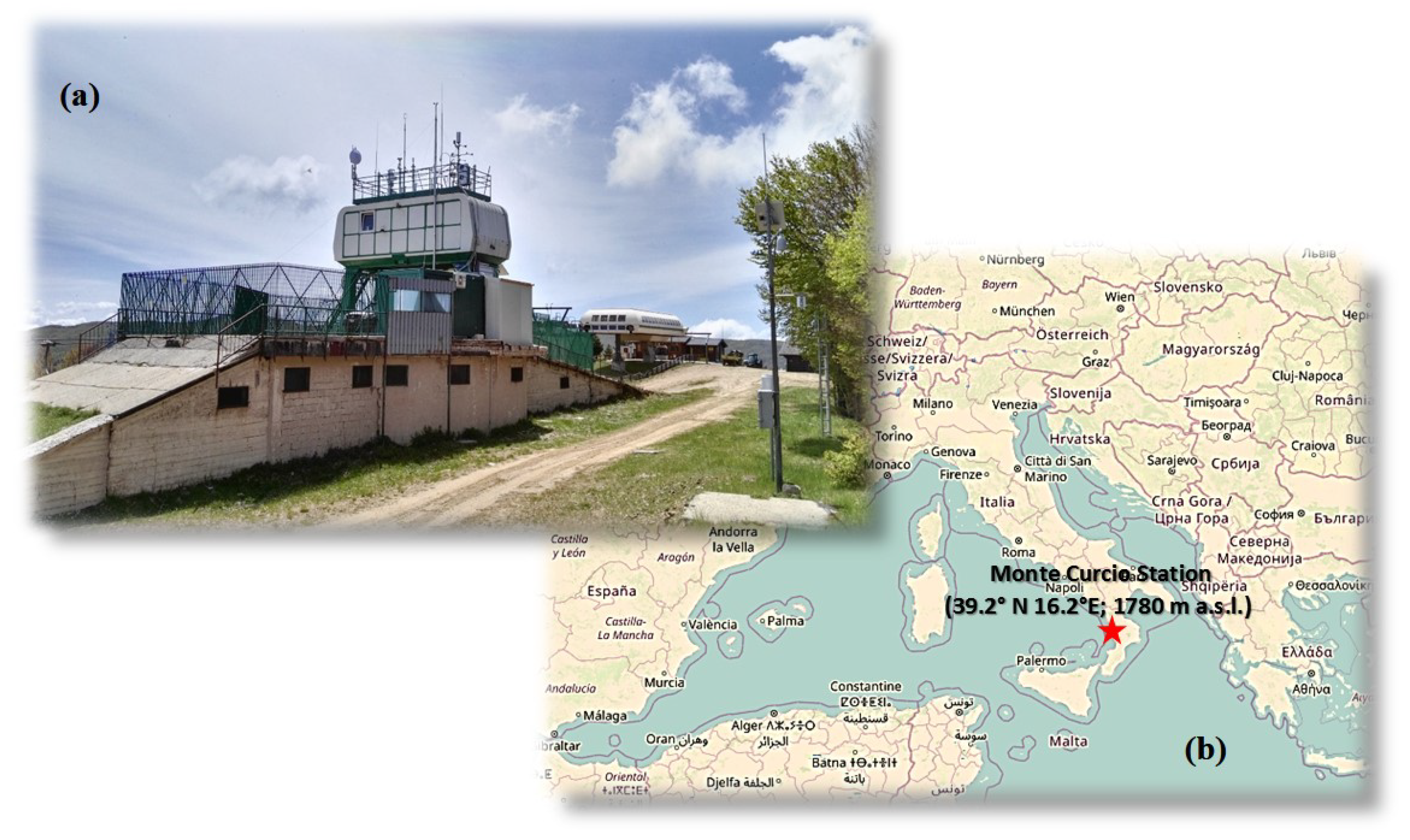
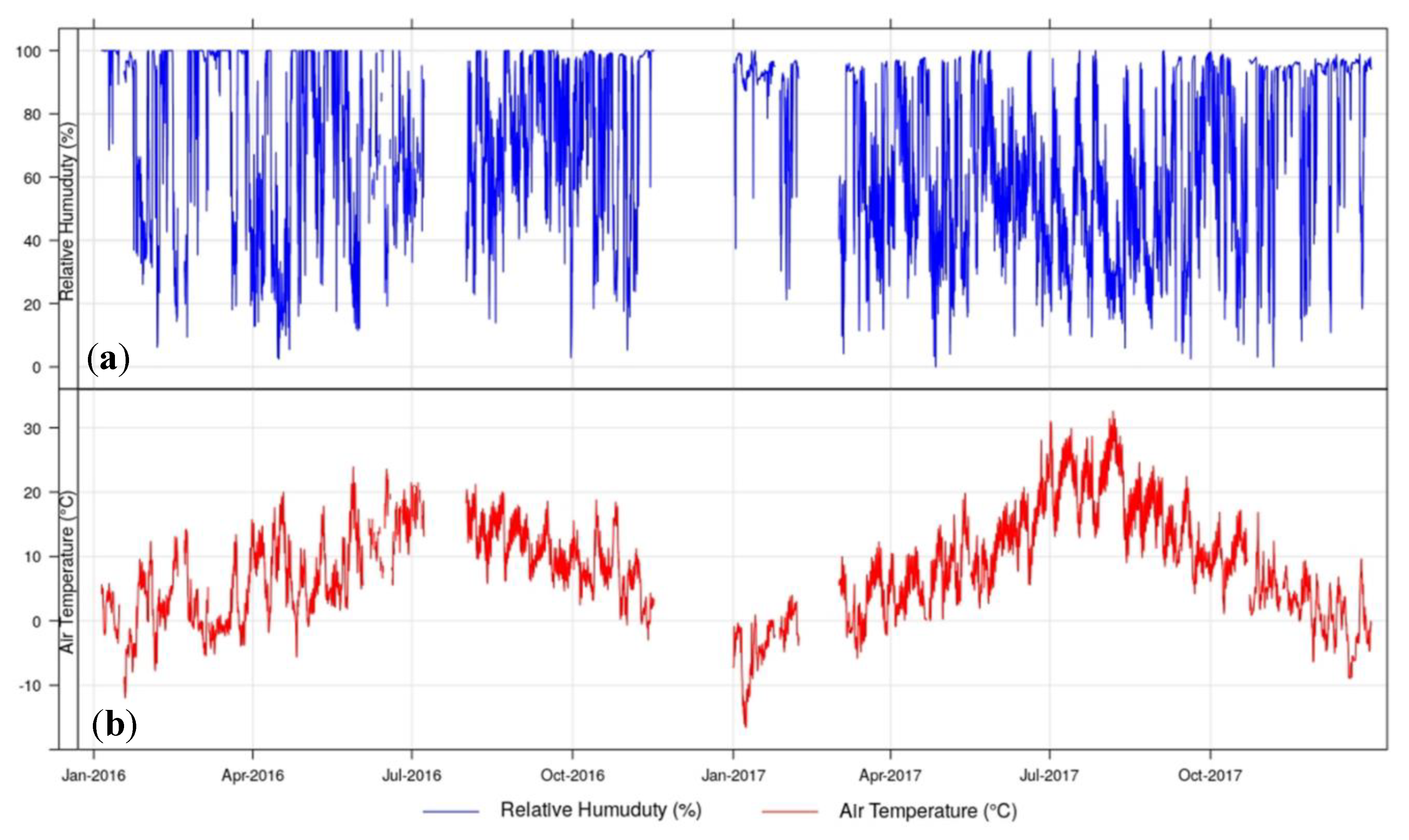
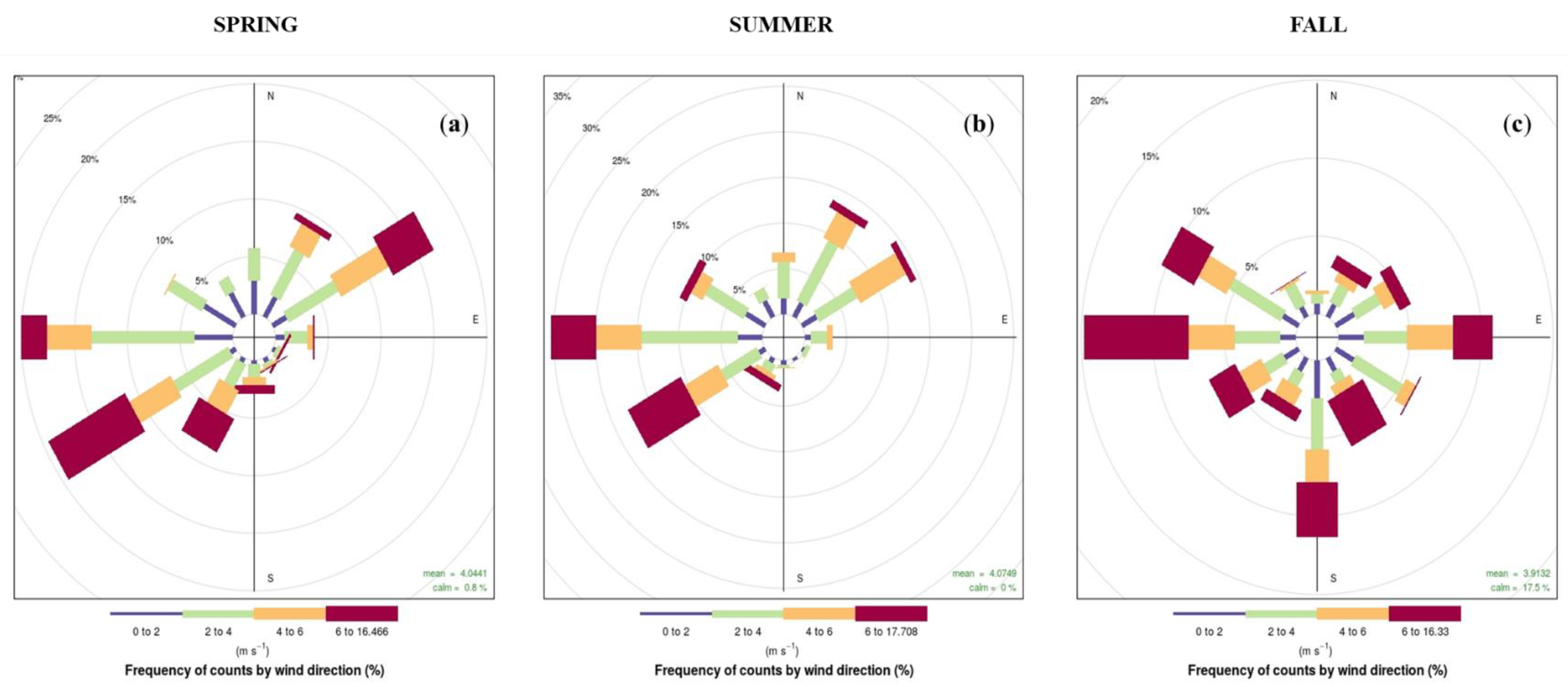
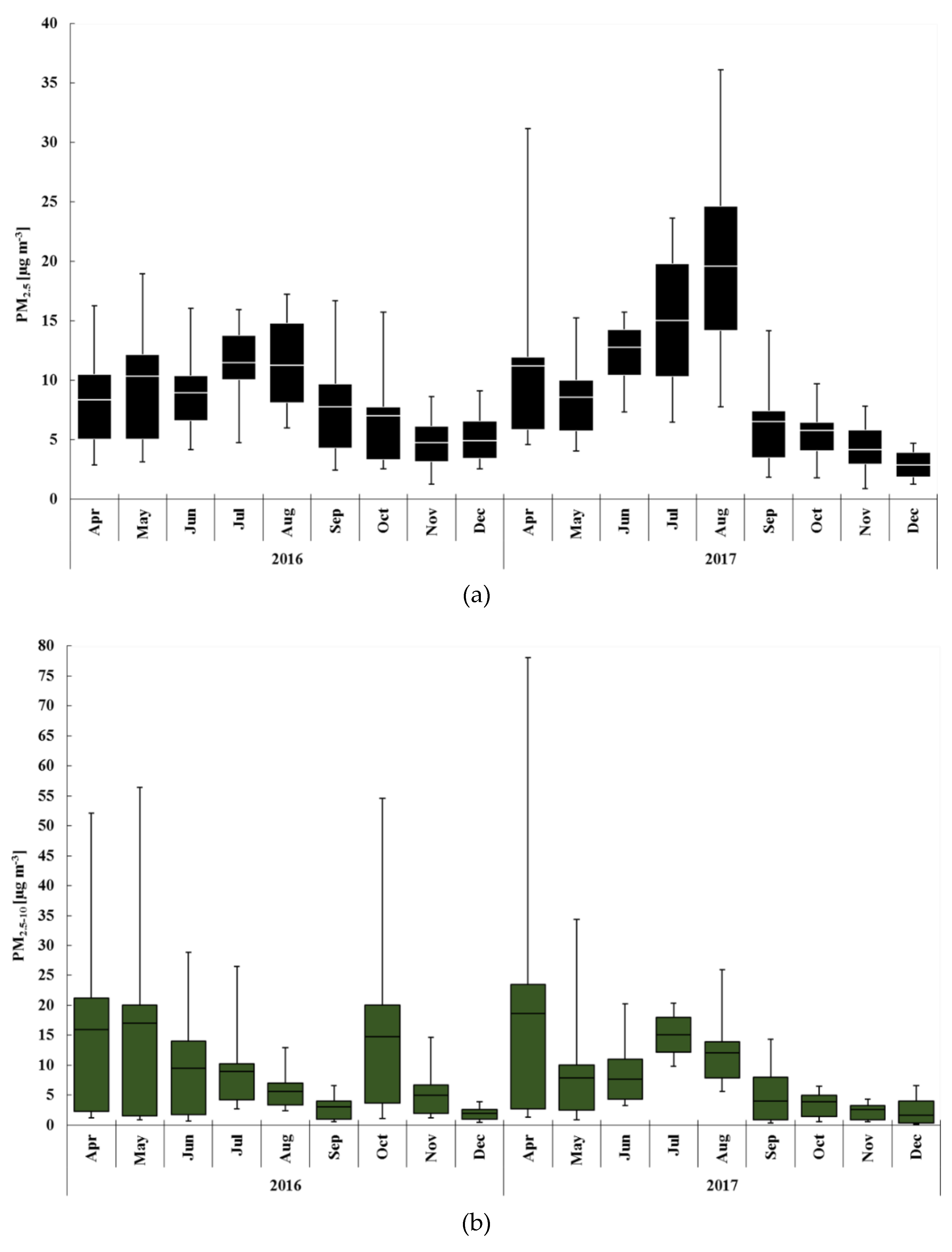
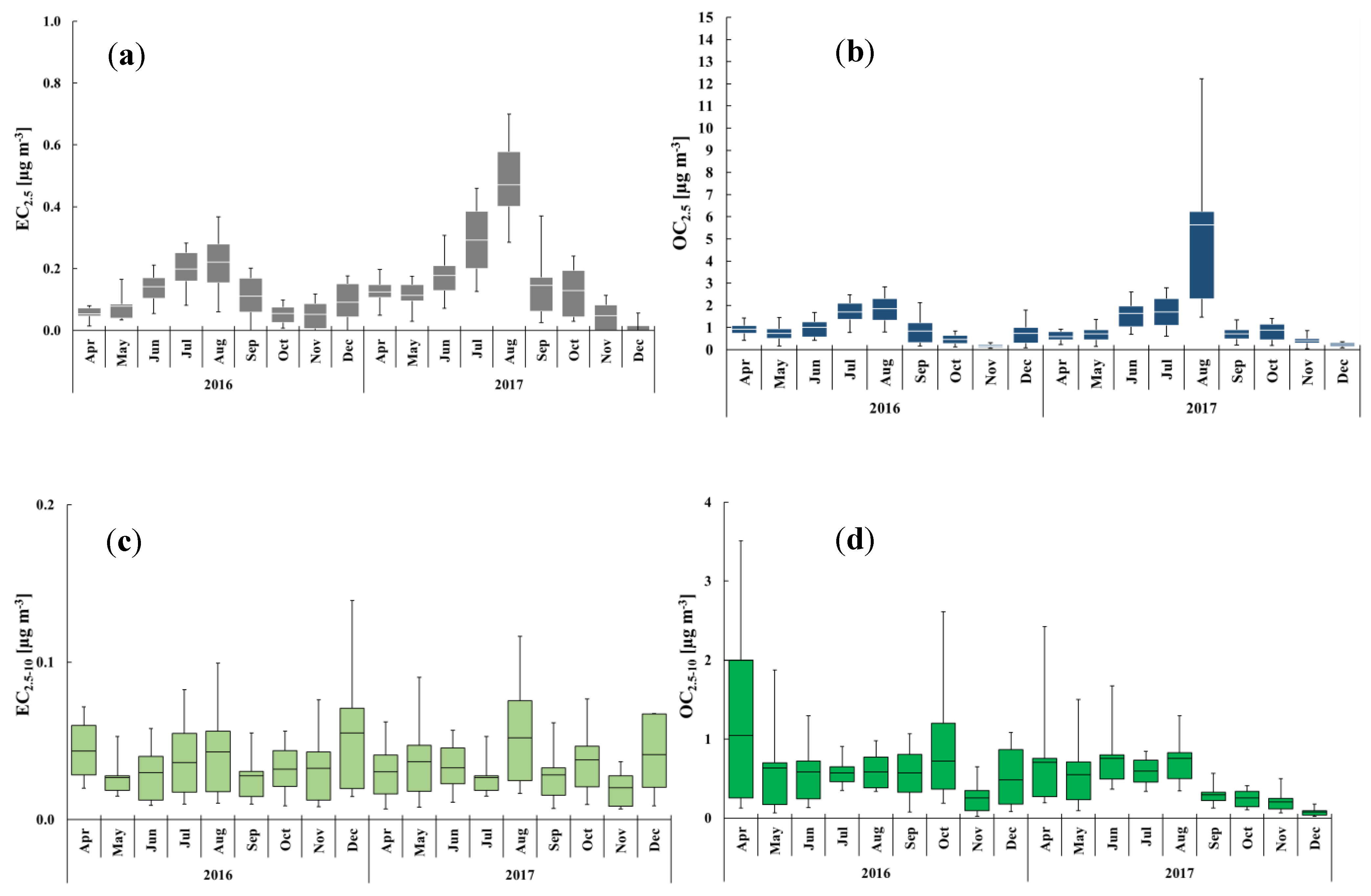
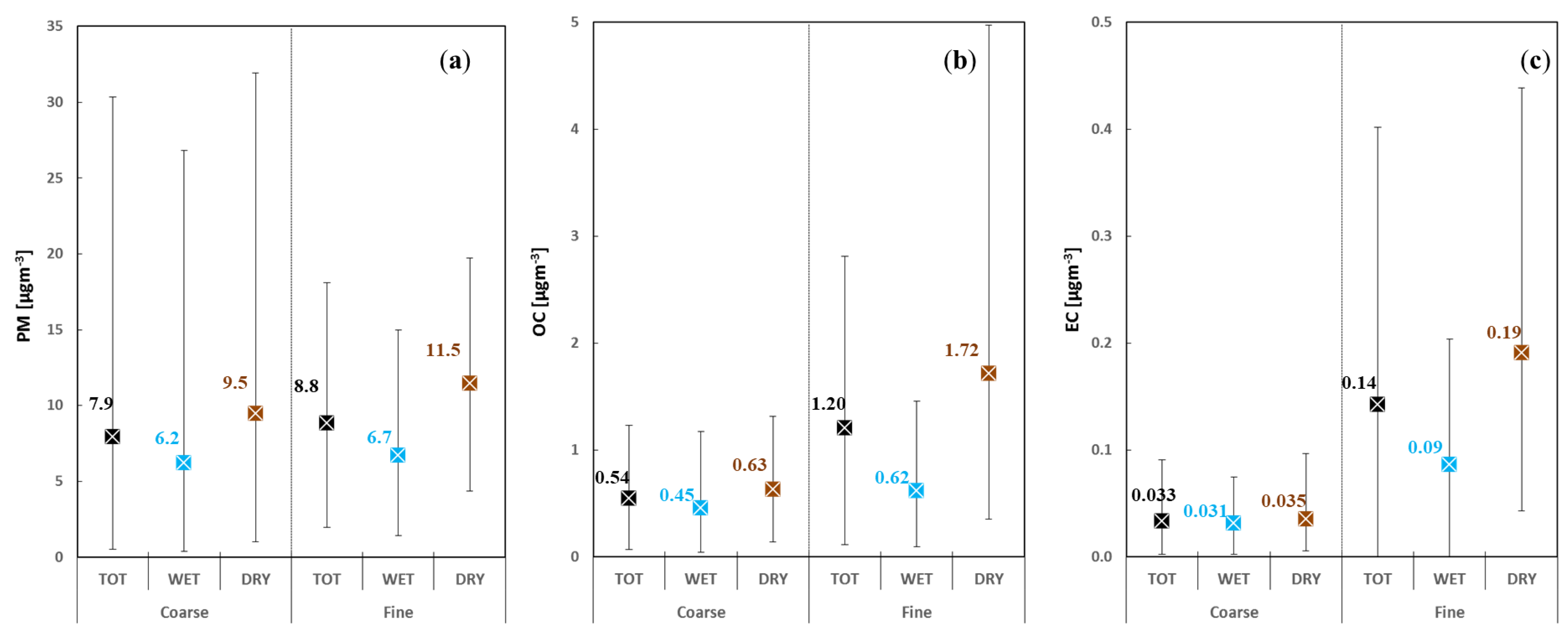

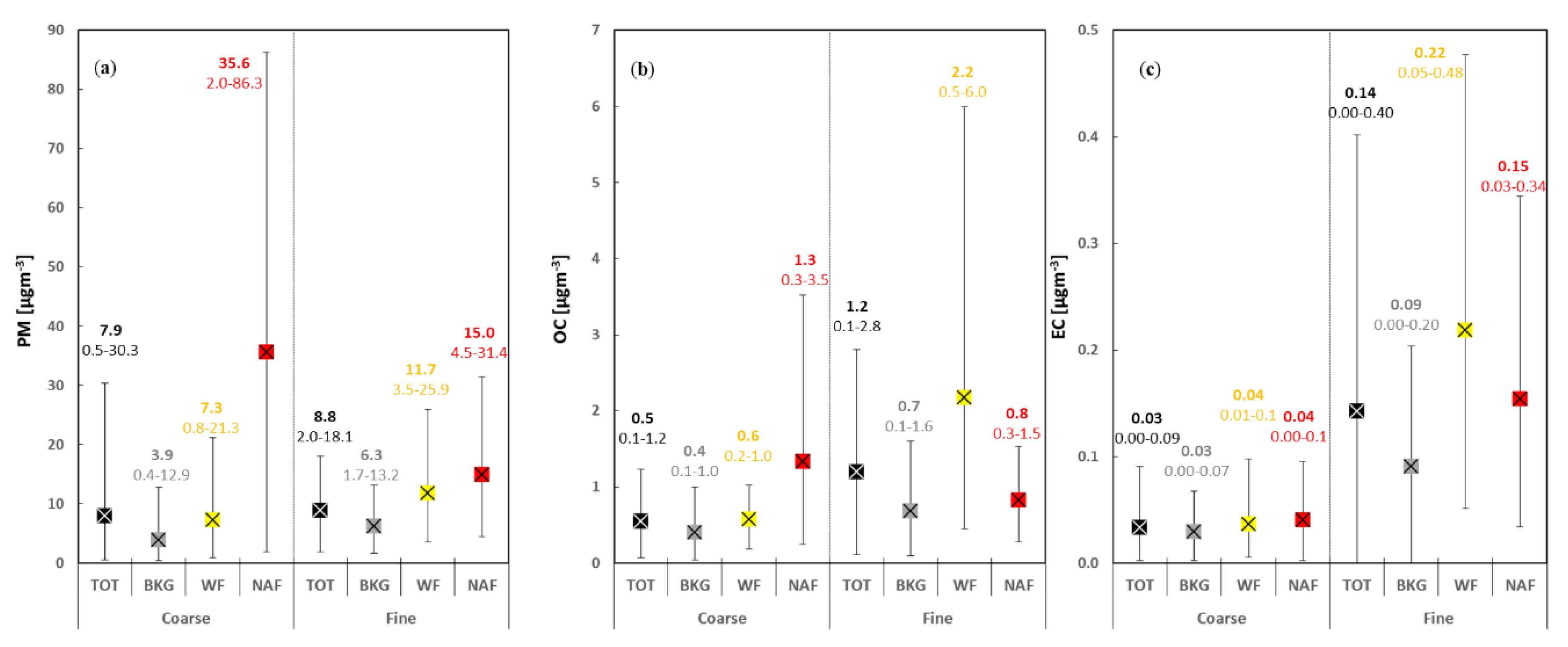
| Spring | Summer | Fall | |
|---|---|---|---|
| BKG | 60% | 29% | 80% |
| WF | 16% | 70% | 14% |
| NAF | 24% | 1% | 6% |
© 2019 by the authors. Licensee MDPI, Basel, Switzerland. This article is an open access article distributed under the terms and conditions of the Creative Commons Attribution (CC BY) license (http://creativecommons.org/licenses/by/4.0/).
Share and Cite
Bencardino, M.; Andreoli, V.; D’Amore, F.; Simone, F.D.; Mannarino, V.; Castagna, J.; Moretti, S.; Naccarato, A.; Sprovieri, F.; Pirrone, N. Carbonaceous Aerosols Collected at the Observatory of Monte Curcio in the Southern Mediterranean Basin. Atmosphere 2019, 10, 592. https://doi.org/10.3390/atmos10100592
Bencardino M, Andreoli V, D’Amore F, Simone FD, Mannarino V, Castagna J, Moretti S, Naccarato A, Sprovieri F, Pirrone N. Carbonaceous Aerosols Collected at the Observatory of Monte Curcio in the Southern Mediterranean Basin. Atmosphere. 2019; 10(10):592. https://doi.org/10.3390/atmos10100592
Chicago/Turabian StyleBencardino, Mariantonia, Virginia Andreoli, Francesco D’Amore, Francesco De Simone, Valentino Mannarino, Jessica Castagna, Sacha Moretti, Attilio Naccarato, Francesca Sprovieri, and Nicola Pirrone. 2019. "Carbonaceous Aerosols Collected at the Observatory of Monte Curcio in the Southern Mediterranean Basin" Atmosphere 10, no. 10: 592. https://doi.org/10.3390/atmos10100592
APA StyleBencardino, M., Andreoli, V., D’Amore, F., Simone, F. D., Mannarino, V., Castagna, J., Moretti, S., Naccarato, A., Sprovieri, F., & Pirrone, N. (2019). Carbonaceous Aerosols Collected at the Observatory of Monte Curcio in the Southern Mediterranean Basin. Atmosphere, 10(10), 592. https://doi.org/10.3390/atmos10100592








